

|
|
#31 |
|
Tomatovillian™
Join Date: May 2009
Location: Floyd VA
Posts: 771
|
Over ripe tomatoes are lower in acid and are generally not recommended for canning. If they are not yet over ripe, you may want to freeze them until the tomato mill arrives. Alternatively you could can them today and add some slightly under ripe tomatoes to the batch to help restore the acidity, or add more acid, such as vinegar, lemon juice, or citric acid. You should add acid in any event as ripe tomatoes are borderline in pH for canning. I add 1/4 tsp of citric acid per pint, which does not have a noticeable effect on taste. All commercial tomato products contain citric acid.
If they are already fully ripe they will likely not make it to next weekend - they tend to begin rotting within a few days of turning fully ripe, and may ruin the finish on your buffet as well. Another option is to skin these tomatoes using the boiling water dip method (dip in boiling water for one minute, then into very cold water). This will make the skins easy to peel by hand. It's more work than milling, but I used it for over 30 years before getting my mill, often on 100-200 tomatoes at a time. TomNJ |
|
|

|
|
|
#32 |
|
Tomatovillian™
Join Date: Jun 2011
Location: Eastern Suburb of Sacramento, CA
Posts: 1,313
|
Hmm. Into the freezer to join their friend they shall go then. I just can't justify doing things the "hard" way when I know I'll have a the right tool for the job in a week. It's like starting a construction project without a hammer and making due with a rock; well maybe not quite, but something along those lines. Thanks for all the good tips and info.
-naysen |
|
|

|
|
|
#33 |
|
Tomatovillian™
Join Date: Feb 2006
Location: Den of Drunken Fools
Posts: 38,539
|
I'm going to take the Hocus Pocus out of the acid discussion.
The proper acid level for water bath canning is 4.6 or lower. Get a meter and take out the guess work. The amount of acid in a tomato or any other fruit is masked by the amount of sugar in the said fruit more so than the variety. This is why people think that some tomatoes are more acid then others. The more ripe a tomato or fruit gets the more sugar is produced to hide this acidity. Many processed foods give me heartburn to no end and some dont. The preservatives they put in this food is what does it to me. I have to buy by brand as some products have more preservatives (including salt) than others. The point I am trying to make is that if you put up your own food you are more than likely trying to get away from processed food. If so then why would a person want to make what they are trying to get away from. Another thing to remember is most of the salt and sugar we ingest is in processed food not from the salt shaker or sugar bowl. So in closing do your body a favor cut back on the preservatives and only use what good sound science says to use. Worth |
|
|

|
|
|
#34 |
|
Tomatovillian™
Join Date: Jun 2011
Location: Eastern Suburb of Sacramento, CA
Posts: 1,313
|
I do have a very nice ph meter, which I plan to employ next week when canning. I'll certainly minimize or eliminate salt, as I have blood pressure issues. I just wish I could get started on this fun today. The intent of my earlier question was in determining whether flavor would be adversely or positively affected by riper than normal ripe tomatoes.
-naysen |
|
|

|
|
|
#35 | |
|
Tomatovillian™
Join Date: Feb 2006
Location: Den of Drunken Fools
Posts: 38,539
|
Quote:
 Many people here eat tomatoes that are on the what I would call the not quite ripe side and in turn have a different idea or opinion on how that tomato tastes. As far as what it would do to your flavor ideas is entirely on you idea of taste alone. The so called "over ripe" mushy fruits would have a negative effect on the texture of the finished product that might be adverse to you likings. Many heirlooms go from ripe to mush real fast, in some cases in a matter of hours. Freezing will make mush out of tomatoes too. I would recommend canning varieties that keep a little longer or not quite ripe for whole or crushed tomatoes and freeze the mushy/soft ((not rotten))ones for sauce as this (freezing)effect will not be noticed. Worth |
|
|
|

|
|
|
#36 |
|
Tomatovillian™
Join Date: May 2009
Location: Floyd VA
Posts: 771
|
I agree that a pH of 4.6 max is considered the safe limit for BWB canning. Most tomatoes are slightly below this level, usually around 4.2-4.4, but some varieties do test over 4.6, and growing conditions and degree of ripeness affect pH as well. For this reason, the folks over at the Harvest forum of Gardenweb and the USDA recommend adding some acid just to be sure. The common acids (vinegar, lemon juice, and citric acid) are natural products and are added just to lower the pH - they are not considered preservatives. The problem with over ripe tomatoes is that the pH rises with ripening, and over ripe tomatoes are more likely to be over 4.6.
I BWB canned tomatoes for over 30 years without adding acids, even though I added lots of low acid ingredients such as onions, garlic, and peppers. After much research I decided increasing the acidity and pressure canning was a smart idea and significantly lowered the risk of botulism. My concern with adding acids was the effect on taste, and I was pleasantly surprised to find that citric acid did not affect the flavor of my salsa recipe. I would have no problem canning just pure tomatoes with no added acid, even in a BWB, provided that the tomatoes were not over ripe. The Harvest forum folks disagree, but then I make my own decisions based on my own research. If adding significant amounts of other low acid ingredients, however, boosting the acid is wise, and pressure canning even wiser. TomNJ |
|
|

|
|
|
#37 |
|
Tomatovillian™
Join Date: Feb 2006
Location: S.W. Ohio z6a
Posts: 736
|
I used lurley's process to can some sauce today. Works great. You can find her process here. http://www.tomatoville.com/showthrea...ghlight=lurley
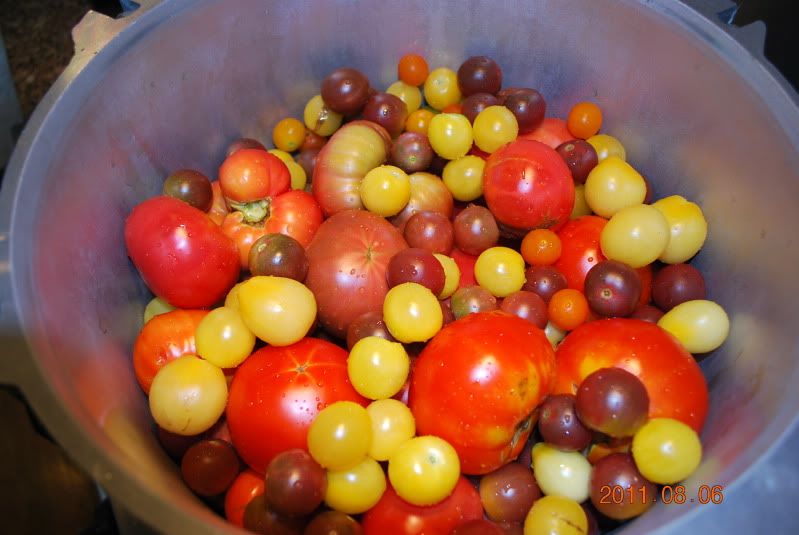 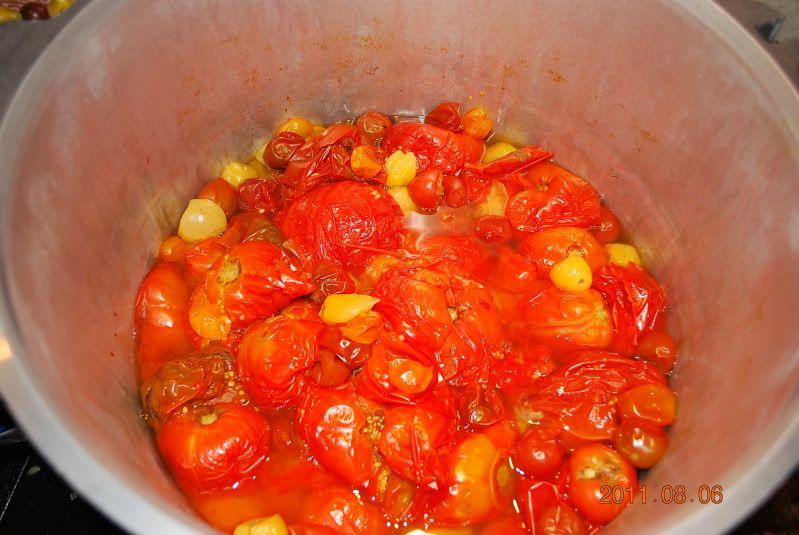 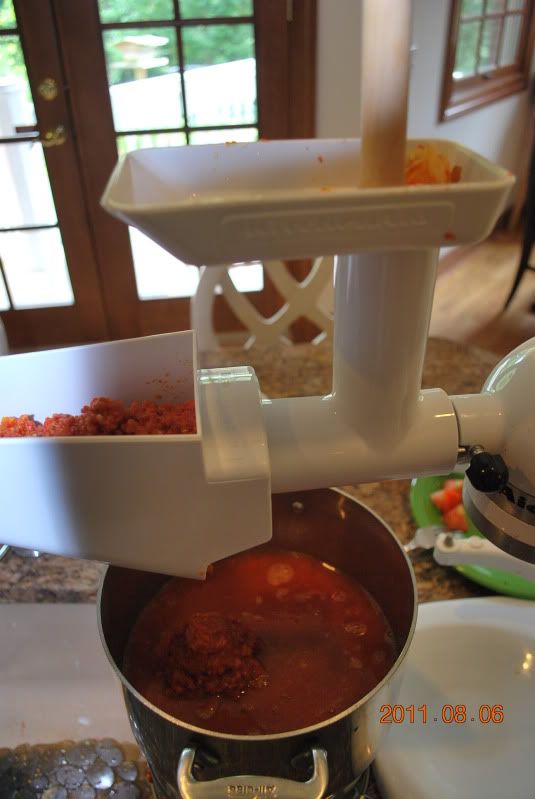 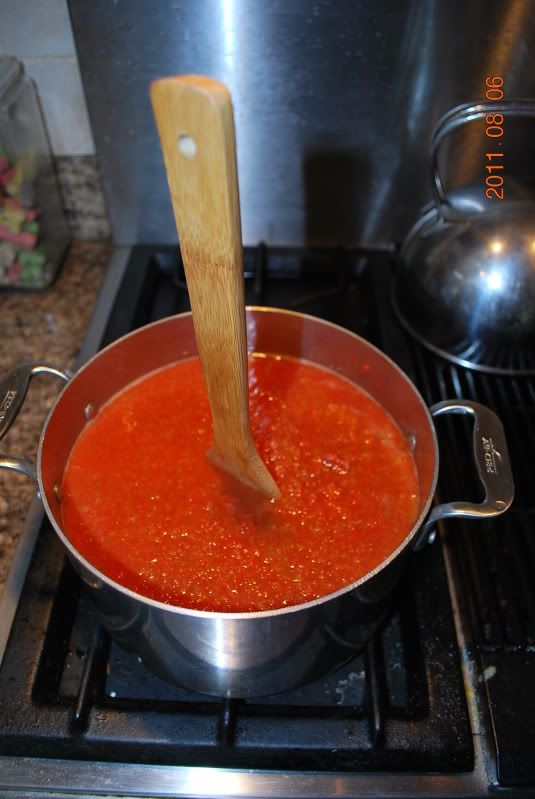 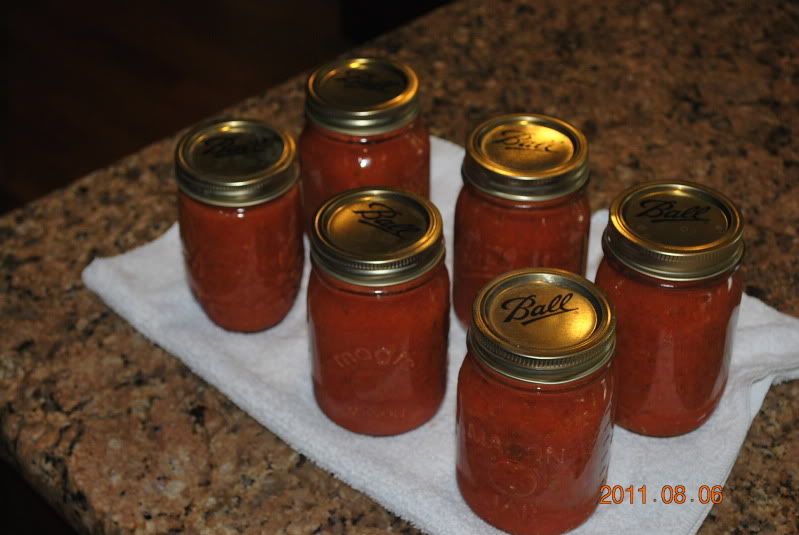
__________________
Jerry |
|
|

|
|
|
#38 |
|
Tomatovillian™
Join Date: Mar 2009
Location: New York State
Posts: 286
|
All of my canned tomato products are reductions so I never have to add acid (checked for safety with a fancy schmancy ph meter).
I agree that citric acid doesn't seem to affect the taste and quality of tomatoes, but vinegar is different. I don't like it added to tomatoes. Naysen, I hope you'll report back with your first impressions of making sauce with your new mill. >Martin
__________________
"The best thing about a vegetable garden is all the meat you can shoot and trap out of it!" 
|
|
|

|
|
|
#39 | |
|
Tomatovillian™
Join Date: Jan 2007
Location: Southwestern Ontario, Canada
Posts: 4,521
|
Quote:
I've got a foley mill somewhere....haven't seen it since the move last year...will have to do more digging through boxes that haven't been unpacked in the basement. I don't usually go to all that trouble for all of my sauces. Most of the time I just cut them up and toss them into the pot. Or run them through the food processor first before tossing them into the pot and reducing down and canning. Either way, I'm looking forward to making more. I'm down to about the last half dozen of all the ones I made in the past 2 years. Sighhhhhh. My maters can't ripen fast enough. Zana |
|
|
|

|
|
|
#40 |
|
Tomatovillian™
Join Date: Apr 2009
Location: SLO, CA
Posts: 99
|
Canned 14 quarts yesterday using frozen tomatoes, a food mill, and water bath. Takes some time, but a nice result. Now there is room to start filling the freezer again.
I agree wholeheartedly with TomNJ's advice. A little common sense and some research will make canning both fun and safe. |
|
|

|
|
|
#41 |
|
Tomatovillian™
Join Date: Jun 2011
Location: Eastern Suburb of Sacramento, CA
Posts: 1,313
|
Jerry, thanks for sharing your photos. IS the point of the Lurly method to reduce/remove the water content of the tomatoes by way of using the pressure cooker to build up pressure and then suddenly evacuate to explode the tomatoes? Seems like the same could be accomplished by a little extra time reducing on the stove top or in the oven. Don't you also run the risk of "polutting" all that great tomato stuff with aluminum from the inside of the pressure cooker? I'm just trying to figure out what makes this alternate method a winner.
BTW, I'm thinking of following the processes described here: http://canningusasupplystore.com/rec...g-tomatoes/182 or maybe here (option-3): http://canningusasupplystore.com/rec...g-tomatoes/174 |
|
|

|
|
|
#42 |
|
Tomatovillian™
Join Date: Feb 2006
Location: S.W. Ohio z6a
Posts: 736
|
Z Yes. The theory is to remove most of the water before cooking. I find this to be much less labor intense. You don’t have to stand by the stove and stir. I only cooked the sauce after putting it through the strainer for about 10 min. Then place in the jars and process.
__________________
Jerry |
|
|

|
|
|
#43 |
|
Tomatovillian™
Join Date: Jan 2011
Location: Central Ohio
Posts: 741
|
Jerry, glad to see you had such great success!
 Z, the benefit of this method is there is NO cooking down needed at all,(ten minutes on the stove to remove the air from straining is all it takes), it's very time and energy efficient and the sauce tastes fresher and less cooked when it's finished too. As you point out, some people are concerned about the aluminum, and here's my opinion on that. The tomatoes are whole right up until the end when they are exploded and are removed immediately after that, so their contact with the aluminum is minimal. My father is a physics/chemistry professor, and while he no longer cooks food in foil packets, he still uses this method, claiming you get more aluminum drinking your soda and beer from aluminum cans than you do from canning tomatoes this way. That said, if you are concerned, and don't have to cram your canner to the brim with tomatoes, (like I do most years), you can place your tomatoes into a smaller, stainless steel pot that will fit inside your canner and then process them the same way. Everyone has to make their own judgment. And while I make all my sauce this way, spaghetti, plain, pizza, etc. I still make a couple batches of conserva every year too. I have aluminum pans, so I cover them with parchment paper or with a silpat, works great and I don't have to buy a special pan to use only once a year. 
|
|
|

|
|
|
#44 |
|
Tomatovillian™
Join Date: Jun 2011
Location: Eastern Suburb of Sacramento, CA
Posts: 1,313
|
Hi All-
My V food mill arrived earlier than expected yesterday, so I pulled out my 8 1-2 gallon bags of tomatoes from my over-labored freezer and set them on a towel to begin the process of thawing out last night. This morning (minutes ago) I checked the bags and the tomatoes all looked partially thawed like deflated water balloons, quite sad looking. There was an awful lot of liquid in the zip-lock bags, which I assume is mainly from the tomatoes (less from freezer burn, condensation). I'm wondering what folks think. Shall I add this freezer tomato run-off liquid to my concoction bowl, or shall I discard it and be glad to have done away with so much unwanted water stuff? I'm not sure how much of the flavor and tomato essence is imparted to that liquid. What do those of you who use the bag and freeze method do? BTW, I've learned a lesson already. I shoved dirty tomatoes from the field right into the freezer bags, but I see now they will be very hard to wash without tearing. I should have washed thoroughly before freezing. Oh well, next time. Lurley, I tend to agree that the limited contact of the tomato pulp on aluminum for such a short time is probably not going to result in an off taste. I have an All American model (which do you use?), and I just read in the manual last night some heavy warnings about not cooking certain foods prone to popping, foaming, exploding, as they don't want the matter to block pressure values and air-ways on the lid. Aren't you similarly concerned? Another thing I'm worried about in the practical side of implementing your method with the All American, is the job of actually removing the lid while the contents are under heavy pressure. That's another thing the manual states is a big no no. Apparently, the vacuum makes it awful difficult to pry the gasket-less lid off, even when the contents have cooled inside. Do you have an All American or similar model, and if so, exactly how do you affect the sudden pressure differential (high to low)? Thanks, Naysen |
|
|

|
|
|
#45 |
|
Tomatovillian™
Join Date: Feb 2006
Location: S.W. Ohio z6a
Posts: 736
|
Hi Z,
I’m not Lurley but I play her in the canning room.  First, I did not taste anything other than tomato when I used her method.  The short amount of time the tomatoes are in contact with the aluminum is not significant enough to present a problem. IMHO. The short amount of time the tomatoes are in contact with the aluminum is not significant enough to present a problem. IMHO.As for removing the lid. My All American has both a gauge and a weight. As Lurley states in her directions, once the pressure reaches #10, turn off the fire, remove the weight and let the pressure reduce to zero. Then removing the lid is not an issue.
__________________
Jerry |
|
|

|
 |
|
|
